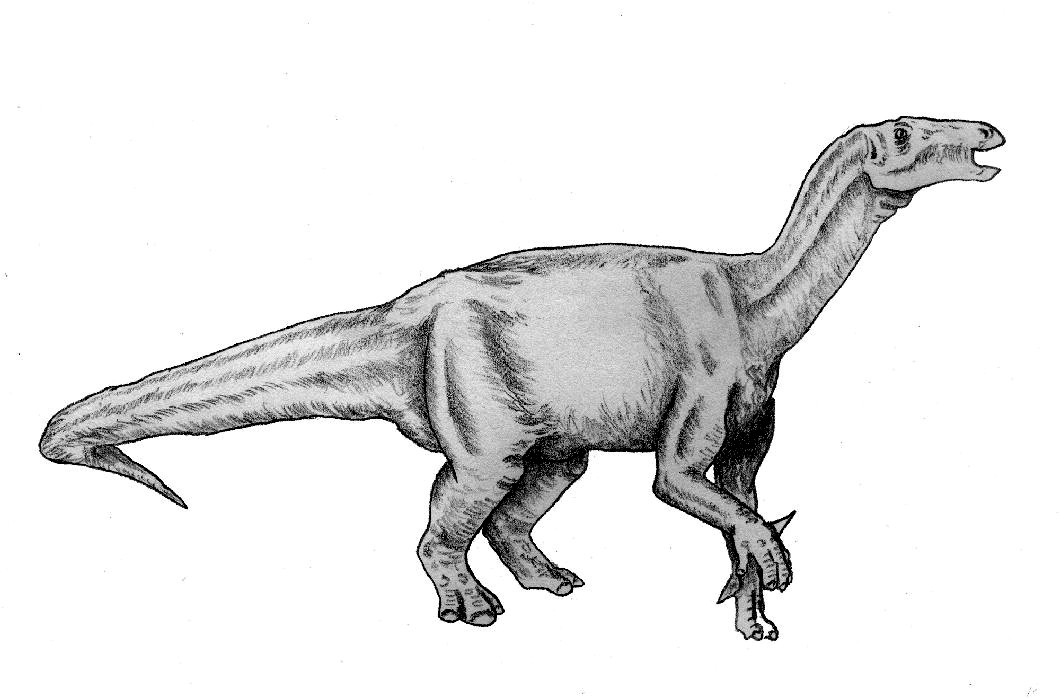- Lurdusaurus
Taxobox|
name = "Lurdusaurus"|

image_width = 200px
image_caption =
regnum =Animal ia
phylum = Chordata
classis =Sauropsid a
superordo =Dinosaur ia
ordo =Ornithischia
subordo =Ornithopod a
infraordo =Iguanodontia
familia =Iguanodontid ae
genus = "Lurdusaurus"
genus_authority = Taquet and Russell (1999)
subdivision_ranks =Species
subdivision =
* "Lurdusaurus arenatus" (type species )"Lurdusaurus" (name meaning 'weighty lizard') is a
genus of largeornithopod dinosaur which lived in theAptian stage of the EarlyCretaceous , about 121 to 112 million years ago. Its fossils have been found inNiger . Thetype species , "Lurdusaurus arenatus", was formalized by Taquet and Russell in 1999; previously, the animal was known informally as "Gravisaurus tenerensis".Unusual build
"Lurdusaurus" is widely thought to have bore a superficial resemblance to the giant
ground sloth s, hugeherbivorous mammal s that were commonplace during thePliocene andPleistocene epochs. It was enormously heavily built, with an estimated length of 30ft (9m), 40% shorter than "Spinosaurus ", the longest carnivorous dinosaur known to date, but probably with around the same mass, 6 tons (6 tonnes). Its torso was characteristically low-slung, with the abdomen as little as 2.4ft (0.71m) above ground level, its neck was fairly long (5.3ft [1.6m] ) and its tail relatively shorter than that of other ornithopods. Like many other large basal iguanodonts, the forelimbs were long and powerful, with the innermost digit of each hand consisting of little more than a large conical claw, presumably used for defense.Defense
Due to its hefty and apparently ungainly build, "Lurdusaurus" was most likely a slow-moving animal, not built for speed and therefore probably not capable of fast retreats from predators. However, its low-slung torso, while prohibiting it from running at high speeds, would have given it a low
centre of gravity , allowing it to suddenly wheel round to face an attacker. Its thumb claws would have been formidable weapons, able to inflict possibly fatal damage to a predator if a blow was delivered to the neck or flank.Contemporaneous dinosaurs
"Lurdusaurus" was contemporaenous with the bizarre large theropod "
Suchomimus ", which some believe to be synonymous with the slightly earlier "Baryonyx " fromEngland , and with the sympatric "Ouranosaurus ", notable for its tall-spinedvertebra e. The remains of an as-yet unnamedallosauroid theropod have also been found in theAptian of Niger. Other contemporaneous dinosaurs (not known from the same location as "Lurdusaurus") include the large allosauroid theropod "Acrocanthosaurus ", known to have had tall-spined vertebrae, the basal iguanodont "Tenontosaurus ", thedromaeosaurid "Deinonychus " and the largenodosaurid ankylosaur "Sauropelta ", all from North America, the basal iguanodont "Muttaburrasaurus ", the large-eyed basal ornithopod "Leaellynasaura " and a possible genus of allosauroid known only from an astragalus, all from Australia, and yet another basal iguanodont, "Probactrosaurus ", the primitiveceratopsia n "Psittacosaurus " and the poorly known and taxonomically problematic large theropod "Chilantaisaurus ", all from East Asia.References
* [http://www.users.qwest.net/~jstweet1/iguanodontia.htm Iguanodontia]
Wikimedia Foundation. 2010.
